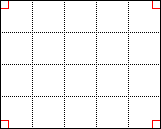.
Rectangle

A 5 by 4 rectangle
In geometry, a rectangle is defined as a quadrilateral where all four of its angles are right angles.
From this definition, it follows that a rectangle has two pairs of parallel sides; that is, a rectangle is a parallelogram. A square is a special kind of rectangle where all four sides have equal length; that is, a square is both a rectangle and a rhombus. A rectangle that is not a square is colloquially known as an oblong.
Normally, of the two opposite pairs of sides in a rectangle, the length of the longer side is called the length of the rectangle, and the length of the shorter side is called the width.
The area of a rectangle is the product of its length and its width; in symbols, A = lw. For example, the area of a rectangle with a length of 5 and a width of 4 would be 20, because ![]()
In a rectangle the diagonals cross each other at their respective midpoints, under the same argument as for parallelograms. Unlike general parallelograms the two diagonals of a rectangle have the same length, the length of the diagonal can be found using the Pythagorean theorem.
In calculus, the Riemann integral can be thought of as a limit of sums of the areas of arbitrarily thin rectangles.
See also
* Cuboid
* Hyperrectangle
* Rectangular function
Links
* Animated course (Construction, Circumference, Area)
* Eric W. Weisstein, Rectangle at MathWorld.
* Definition and properties of a rectangle With interactive animation
* Area of a rectangle with interactive animation
Undergraduate Texts in Mathematics
Graduate Studies in Mathematics
Retrieved from "http://en.wikipedia.org/"
All text is available under the terms of the GNU Free Documentation License

